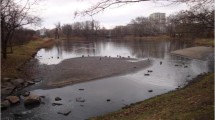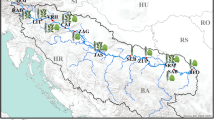Abstract
The aim of this study was to assess the potential for application of Hudson River sediment as a plant growth medium by mixing with various proportions of soil. The growth medium obtained by the admixture of soil and Hudson River sediment was characterized by optimal pH, reduced salinity, and presence of macro- (K, Mg) and micronutrients (Fe, Mn). Apart from beneficial nutrients and organic matter, the riverine sediment also contained toxic metals (Zn 86 mg; Cu 17.8 mg; Ni 16.6 mg; Cr 20.7 mg; Cd 0.46 mg; Pb 20.7 mg/kg, at concentrations below the threshold effect concentration) and PCBs (total concentration 254 ng/g), which can have a negative impact on soil ecosystems. The results ecological risk assessment of six trace elements and PCBs in sediment suggested medium/moderate risk (PECq = 0.21) and the need for ecotoxicological tests prior to its use as a growth medium. However, ecotoxicity tests of the soil/sediment admixture indicated that it was non-toxic or less-toxic to crustacean Heterocypris incongruens (PE = − 8–38%) and bacteria Aliivibrio fischeri (PE = − 20–38). For Sinapis alba L. and Lepidium sativum L., the germination index (GI) indicated the dominance of inhibitory effect on plant growth; whereas for the Sorghum saccharatum L., the GI value showed the stimulatory effect. Based on the above physicochemical and ecotoxicological analyses, the sediment was found suitable for use as a growth medium, for non-edible plants. It is worth to underline that this sediment was collected from relatively less contaminated location of the river and therefore the results may not represent sediments from entire stretch of the Hudson River.


Similar content being viewed by others
References
Antonkiewicz J, Baran A, Pełka R, Wisła-Świder A, Nowak E, Konieczka P (2018) A mixture of cellulose production waste with municipal sewage as new material for an ecological management of wastes. Ecotoxicol Environ Saf 169:607–614
Baran A, Tarnawski M (2013) Phytotoxkit/Phytotestkit and Microtox® as tools for toxicity assessment of sediments. Ecotoxicol Environ Saf 98:19–27
Baran A, Tarnawski M (2015) Assessment of heavy metals mobility and toxicity in contaminated sediments by sequential extraction and a battery of bioassays. Ecotoxicology 24(6):1279–1293
Baran A, Tarnawski M, Koniarz T, Jasiewicz CZ (2016) Agricultural use of sediments from Narożniki reservoir - yield and concentration of macronutrients and trace elements in the plant. Infrastruct Ecol Rural Areas 4:1217–1228
Baran A, Tarnawski M, Urbaniak M (2019) An assessment of bottom sediment as a source of plant nutrients and an agent for improving soil properties. Environ Eng Manag J 18(8):1647–1656
Bojakowska I (2001) Criteria for evaluation of water sediments pollution. Pol Geol Rev 49(3):213–219 [in Polish]
Canet R, Chaves C, Pomares R, Alibach R (2003) Agricultural use of sediments from the Albufera Lake (eastern Spain). Agric Ecosyst Environ 95:29–36
Chen L, Wang Z (2018) Enhanced reduction of extractable polychlorinated biphenyls and toxicity in sediment by organic matter. Water Air Soil Pollut 229(12):400
Chen L, Tang X, Shen C, Chen C, Chen Y (2012) Photosensitized degradation of 2,4′,5-trichlorobiphenyl (PCB 31) by dissolved organic matter. J Hazard Mater 201-202:1–6
Chen B, Liu E, Tian Q, Yan C, Zhang Y (2014) Soil nitrogen dynamics and crop residues. A review. Agron Sustain Dev 34:429–442
Cho Y-C, Frohnhoefera RC, Rhee G-Y (2004) Bioconcentration and redeposition of polychlorinated biphenyls by zebra mussels (Dreissena polymorpha) in the Hudson River. Water Res 38(3):796–777
Darmody C, Marlin J, Talbott RA, Green E, Brewer F, Stohr C (2004) Dredged Illinois River sediments. J Environ Qual 33:458–464. https://doi.org/10.2134/jeq2004.4580
Dercova K, Cicmanova J, Lovecka P, Demnerova K, Mackova M, Hucko P, Kusnır P (2008) Isolation and identification of PCB-degrading microorganisms from contaminated sediments. Int Biodeterior Biodegrad 62:219–225
Dercova K, Šeligová J, Dudášová H et al (2009) Characterization of the bottom sediments contaminated with polychlorinated biphenyls: evaluation of ecotoxicity and biodegradability. Int Biodeterior Biodegrad 63:440–449
Ebbs S, Talbott J, Sankaran R (2006) Cultivation of garden vegetables in Peoria Pool sediments from the Illinois River: a case study in trace element accumulation and dietary exposure. Environ Int 32:766–744
Field LJ, Kern JW, Rosman LB (2016) Re-visiting projections of PCBs in lower Hudson River fish using model emulation. Sci Total Environ 557–558:489–501
Foley RE (1992) Organochlorine residues in New York waterfowl harvested by hunters in 1983-1984. Environ Monit Assess 21:37–48
Fonseca RM, Barriga F, Fyfe WS (2003) Dam reservoir sediment as fertilizers and artificial soils. Case studies from Portugal and Brazil. 4th international symposium of Kanazawa University 21st century COE program, 1a
Jasiewicz CZ, Baran A, Tarnawski M (2010) Effect of bottom sediment on content, bioaccumulation and translocation of heavy metals in maize biomass. J Elem 15:281–291
Karanam PV, Wani SP, Sahrawat KL, Jangawad LS (2008) Economic evaluation of sediment as a source of plant nutrients. Curr Sci 95:1042–1050
Kiełbasa A, Buszewski B (2017) River bottom sediment from the Vistula as matrix of candidate for a new reference material. Ecotoxicol Environ Saf 142:237–242
Kopeć M, Gondek K, Baran A (2013) Assessment of respiration activity and ecotoxicity of composts containing biopolymers. Ecotoxicol Environ Saf 89:137–142
Macdonald DD, Ingersoll CG, Berger TA (2000) Development and evaluation of consensus-based sediment quality guidelines for freshwater ecosystems. Arch Environ Contam Toxicol 39:20–32
Macía SP, Fernández-Costas C, Rodríguez E, Sieiro P, Pazos M, Sanromán MA (2014) Technosols as a novel valorization strategy for an ecological management of dredged marine sediment. Ecol Eng 67:182–189
Madden SS, Skinner LC (2016) Polychlorinated biphenyls (PCBs) in adult and juvenile mallards (Anas platyrhynchos) from the Hudson River, New York, USA. Environ Pollut 216:487e499
Mamindy-Pajany Y, Hamer B, Roméo M et al (2011) The toxicity of composted sediments from Mediterranean ports evaluated by several bioassays. Chemosphere 83(3):362–369
Mamindy-Pajany Y, Geret F, Roméo M, Hurel C, Marmier N (2012) Ex situ remediation of contaminated sediments using mineral additives: assessment of pollutant bioavailability with the Microtox solid phase test. Chemosphere 86:1112
Marlin J, Darmody C (2018) Beneficial use of Illinois River sediment for agricultural and landscaping applications. Illinois Sustainable Technology Center Prairie Research, Institute University of Illinois at Urbana-Champaign, 144 pp. https://www.istc.illinois.edu/UserFiles/Servers/Server_427403/File/TR068.pdf
Mattei P, D'Acqui LP, NiceseFP LG, Masciandaro G, Macci C, Doni S, Sarteschi F, Giagnoni L, Renella G (2017) Use of phytoremediated sediments dredged in maritime port as plant nursery growing media. J Environ Manag 186:225–232
Microbics Corporation (1992) Microtox manual toxicity testing handbook. Carlsbad, CA, USA
Middleton BA, Jiang M (2013) Use of sediment amendments to rehabilitate sinking coastal swamp forests in Louisiana. Ecol Eng 54:183–191
Mierzejewska E, Baran A, Urbaniak M (2018) The influence of MCPA on soil ecotoxicity and the presence of genes involved in its biodegradation. Arch Environ Prot 44(4):58–64
Mierzwa-Hersztek M, Gondek K, Klimkowicz-Pawlas A, Baran A (2017) Effect of wheat and Miscanthus straw biochars on soil enzymatic activity, ecotoxicity, and plant yield. Int Agrophys 31:367–375
Mouendo P, Verderem M, Stoorvogel J et al (2014) Sediment accumulation in fish ponds; its potential for agricultural use. Int J Fish Aquat Stud 5:228–241
O’Keefe PW, Clayton WC, Connor S, Bush B, Hong CS (2006) Organic pollutants in wild ducks from New York state: I. interspecies differences in concentrations and congener profiles of PCBs and PCDD/PCDFs. Sci Total Environ 361:111–123
Oleszczuk P (2008) The toxicity of compost from sewage sludges evaluated by direct contact tests phytotoxkit and ostracodtoxkit. Waste Manag 28:1645–1653
Oleszczuk P, Hollert H (2011) Comparison of sewage sludge toxicity to plants and invertebrates in three different soils. Chemosphere 83(4):502–509
Ostracodtoxkit F (2001) Direct contact toxicity test for freshwater sediments. Standard operational procedure. MicroBioTest Inc, Nazareth, p 35
Parkpian P, Leong ST, Laortanakul P, Phuong NT (2002) The benefits and risks of using river sediment for Vietnamese agriculture: a case study of the Nhieu Loc canal in Ho Chi Minh City. J Environ Sci Health A Tox Hazard Subst Environ Eng 37(6):1099–1122
Perrodin Y, Babut M, Beddel JB et al (2006) Assessment of ecotoxicological risks related to depositing dredged materials from canals in northern France on soil. Environ Int 32:804–814
Persoone G, Marsalek B, Blinova I et al (2003) A practical and user-friendly toxicity classification system with microbiotests for natural waters and wastewaters. Environ Toxicol 18(6):395–402
Phytotoxkit (2004) Seed germination and early growth microbiotest with higher plants. Standard Operational Procedure. MicroBioTest Inc, Nazareth, p 24
Pinkney AE, Myers MS, Rutter MA (2017) Histopathology of brown bullhead (Ameiurus nebulosus), smallmouth bass (Micropterus dolomieu), and yellow perch (Perca flavescens) in relation to polychlorinated biphenyl (PCB) contamination in the Hudson River. Sci Total Environ 575:1325–1338
Sheehan C, Harrington J, Murphy JD (2010) A technical assessment of topsoil production from dredged material. Resour Conserv Recycl 54:1377–1385
Shi H, Wang X, Xu M, Zhang H, Luo Y (2017) Characteristics of soil C:N ratio and δ13C in wheat-maize cropping system of the North China plain and influences of the Yellow River. Sci Rep 7(1):16854
Siebielec S, Siebielec G, Urbaniak M, Smreczak B, Grzęda E, Wyrwicka A, Kidd PS (2019) Impact of rhizobacterial inoculants on plant growth and enzyme activities in soil treated with contaminated bottom sediments. Int J Phytoremediation. https://doi.org/10.1080/15226514.2018.1524833
Siham K, Fabryce B, Edine N, Patrick D (2008) Marine dredged sediments as new materials resource for road construction. Marine dredged sediments as new materials resource for road construction. Waste Manag 28:919–928
Szara M, Baran A, Tarnawski M, Koniarz T (2017) The application of the germination index in the assessment of the phytotoxicity of bottom sediments from the Rybnik reservoir. Geol Geophys Environ 43(4):327–333
Talgre L, Roostalu H, Mäeorg E, Lauringson E (2017) Nitrogen and carbon release during decomposition of roots and shoots of leguminous green manure crops. Agron Res 15(2):594–601
Tarnawski M, Baran A (2018) Use of chemical indicators and bioassays in bottom sediment ecological risk assessment. Arch Environ Contam Toxicol. https://doi.org/10.1007/s00244-018-0513-2
Tarnawski M, Baran A, Koniarz T (2015) The effect of bottom sediment supplement on changes of soil properties and on the chemical composition of plants. Geol Geophys Environ 41:285–292
Tarnawski M, Baran A, Koniarz T, Wyrębek M, Grela J, Piszczek M, Koroluk A (2017) The possibilities of the environmental use of bottom sediments from the silted inlet zone of the Rożnów reservoir. Geol Geophys Environ 43:335–344
Thanh BX, Hien VTM, Trung TC, Da T, Berg H (2015) Reuse of sediment from catfish pond through composting with water hyacinth and rice straw. Sustain Environ Res 25:59–63
U.S. Environmental Protection Agency (US EPA) (2015) Statement from EPA on Hudson River cleanup. October 1, 2015 http://www3.epa.gov/hudson/pdf/statement_hudson_october_1_final.pdf
Urbaniak M (2013) Biodegradation of PCDDs/PCDFs and PCBs. Biodegradation, Rolando Chamy and Francisca Rosenkranz, IntechOpen. https://doi.org/10.5772/56018. Available from:https://www.intechopen.com/books/biodegradation-engineering-and-technology/biodegradation-of-pcdds-pcdfs-and-pcbs
Urbaniak M, Wyrwicka A, Zielinski M, Mankiewicz-Boczek J (2016) Potential for phytoremediation of PCDD/PCDF-contaminated sludge and sediments using Cucurbitaceae plants: a pilot study. Bull Environ Contam Toxicol 97:401–406
Visconti F, de Paz JM (2015) Electrical conductivity measurements in agriculture: the assessment of soil salinity. New Trends Dev Metrol. https://doi.org/10.5772/62741
Wang L, Kwok JH, Tsang DC, Poon CS (2015) Mixture design and treatment methods for recycling contaminated sediment. J Hazard Mater 283:623–632
Yang T, He C, Wang A, Sheng L (2018) Effect of planting and fertilization on lead partitioning in dredged sediment. Ecotoxicology 27(1):69–80
Acknowledgments
The authors would like to thank Mr. Karl Brosch at Wadsworth Center, NYSDOH, for his assistance in conducting the study, and Dr. Hongkai Zhu and Mr. Jin Park for their help during sediment sampling.
Funding
The study was supported by the Kosciuszko Foundation Exchange Program to Magdalena Urbaniak for travel to the USA and by the Polish Ministry of Science and Higher Education.
Author information
Authors and Affiliations
Corresponding author
Ethics declarations
Conflict of interest
The authors declare that they have no conflict(s) of interest.
Additional information
Responsible editor: Elena Maestri
Publisher’s note
Springer Nature remains neutral with regard to jurisdictional claims in published maps and institutional affiliations.
Rights and permissions
About this article
Cite this article
Urbaniak, M., Baran, A., Szara, M. et al. Evaluation of ecotoxicological and chemical properties of soil amended with Hudson River (New York, USA) sediment. Environ Sci Pollut Res 27, 7388–7397 (2020). https://doi.org/10.1007/s11356-019-07354-6
Received:
Accepted:
Published:
Issue Date:
DOI: https://doi.org/10.1007/s11356-019-07354-6




